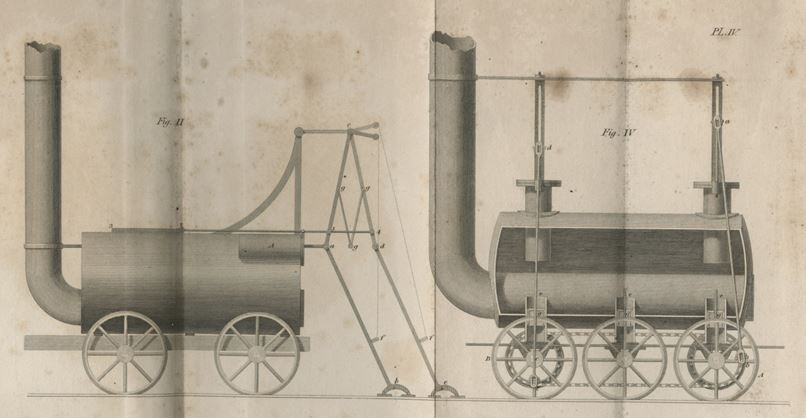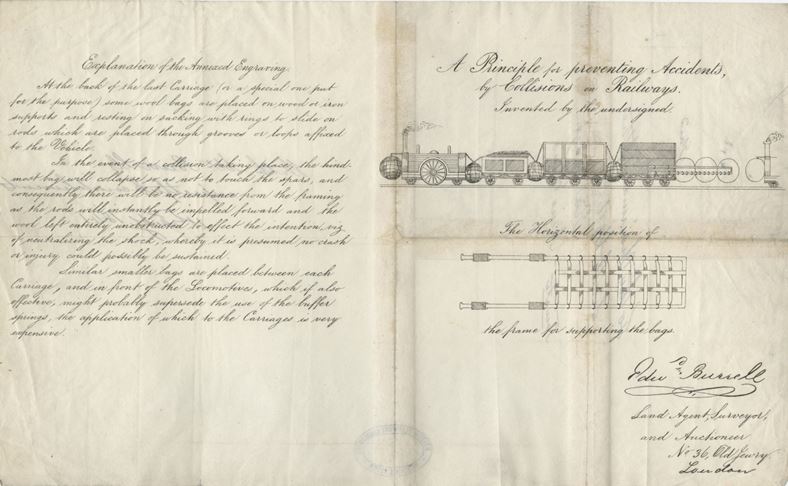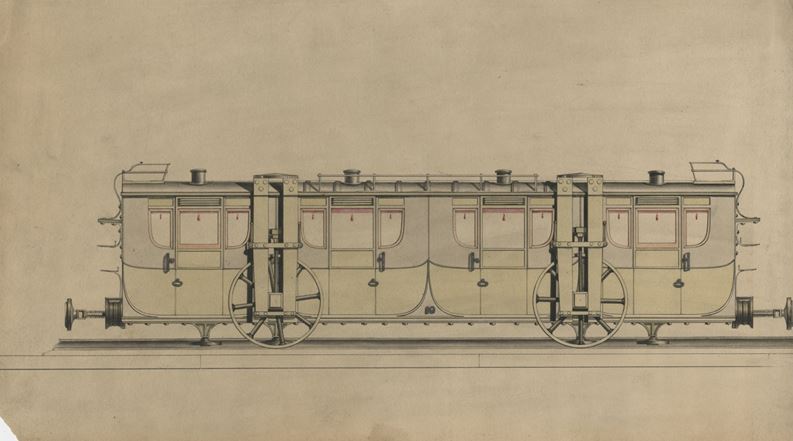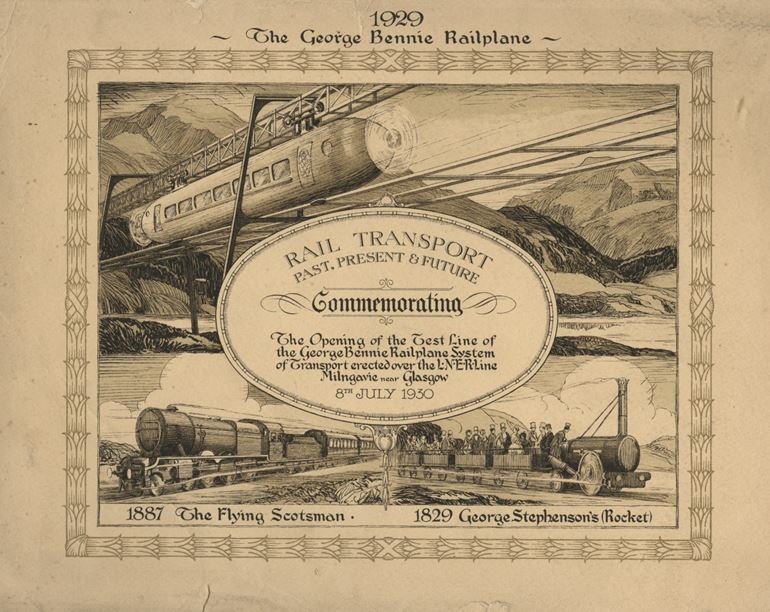The evolution of railway engineering has not just been a linear triumphal march from Richard Trevithick’s first steam locomotives to today’s cutting-edge Maglev trains. Throughout railway history engineers have come up with all manner of ideas which in hindsight look rather implausible and wacky. These were nonetheless born out of a desire to improve current technology and solve practical problems facing the railways. During our work in the museum’s archives we have come across some great examples of alternative solutions to engineering problems faced by the railways throughout their history.
The majority of ‘iron horses’, as early steam locomotives were known, dispensed with the legs that propelled their equine predecessors. However there was one notable exception to this rule, namely William Brunton’s Mechanical Traveller or Steam Horse. First built in 1813, Brunton’s Traveller ‘walked’ forwards by using legs that were connected to an apparatus of pistons and cylinders. The main body of the traveller consisted of a boiler on four wheels that powered the legs. Brunton’s contraption could reach a top speed of 2.5 mph, displace 6 horsepower and ascend gradients of 1 in 36.

Only two Travellers were ever made, both produced at the Butterley Iron Works in Derbyshire. Both engines were financed by Brunton himself and he had high hopes for the success of his invention. The two engines were put into use at the Crich Railway and Newbottle Colliery.
Unfortunately Brunton’s Mechanical Traveller had the dubious distinction of being the cause of the world’s first railway accident when the boiler exploded on the Newbottle Colliery engine on 13 July 1815. The explosion caused the loss of 13 lives with another 43 people suffering injuries. This horrific accident seems to have put a pall on enthusiasm for the Mechanical Traveller and Brunton moved on to concentrate on other engineering ideas. The simplicity and widespread adoption of conventional wheel arrangements rendered the Steam Horse obsolete.
Another early example of unconventional railway engineering addressed the safety of trains during collisions, a regular occurrence in the nineteenth century due to ineffective brakes and rudimentary signalling systems. This system proposed putting large woollen bags between the carriages and at the ends of trains to act as a shock absorber in the event of a crash. It was hoped that these bags would supersede sprung buffers as these were expensive to manufacture. The system acts on the same principle as fenders that protect a boat whilst mooring.

The inventor, Mr. Burrell, doesn’t offer any engineering credentials and the design seems to have been submitted on his initiative, demonstrating the energetic entrepreneurialism and fever for technological innovation that was generated by the early railways. Despite the safety benefits that this solution offered it was never implemented in practice as far as we are aware.
A train with wheels on the outside of the track may seem strange today but in the 1840s and 50s it was an everyday occurrence for commuters on their way into Paris.

This line was unique for using the Arnoux system which was invented by Jean-Claude-Republicain Arnoux in an attempt to allow trains to travel around much tighter curves than was possible at the time. The way he achieved this was by pivoting each axle of the carriages in the centre so they could freely follow the curves. Each axle also had four guide wheels, two for each wheel, set at right angles to keep the track in line with it. As well as the carriage, the locomotives for the railway also used a similar system whereby the front and rear wheels had a similar set up to the carriage while the driving wheels where flangeless. This allowed them to slide across the top of the track as the train went round the sharper corners, sometimes requiring an extra track on the inside to prevent derailing.
It was hoped that this could be used to reduce the cost of the building railways as major work wouldn’t be needed to build gentler curves. Despite its early success at doing this the system failed partly due to its unique gauge, 5ft 8 ¾ was needed to allow space for the guide wheels and the invention of the bogie in the 1850s allowed conventional trains to negotiate similarly tight curves. Although the Arnoux system continued to be used for a short time it was abandoned in the late 1860s when the company was taken over by the Paris-Orleans Railway and the track converted to standard gauge. Much of the route is now part of the Paris suburban railway, the RER.
Whilst most railways were designed with the train’s wheels firmly on the ground, a Scottish inventor, George Bennie came up with the idea for railway in the sky in the 1920s. Bennie’s Railplane was a suspended railway that was driven by propellers. It was conceived as a low-cost means of separating slow-moving freight and passenger rail traffic as Bennie saw congestion as a threat to the future viability of the railways. The Railplane gantry was to be erected above a conventional rail line or road and would allow passengers to travel safely, swiftly and commodiously. This meant the conventional railways could operate a greater volume of freight traffic which was an area of their business that they were losing to road haulage firms.

A test track was constructed over the LNER line in Milngavie and it opened to much fanfare in 1929, even hosting a delegation of LNER officials. However Bennie’s funding soon ran out as orders did not materialise. Several outlandish schemes were proposed, including a Railplane link between London and Paris (the Channel crossing was to be made by seaplane) and even a Railplane connection between Baghdad and Damascus. Bennie’s concept didn’t take off as its novelty and impracticality prevented its wider adoption. However another suspended railway, the Wuppertaler Schwebebahn in Germany, has proved more successful and is still in use today.

Whilst all these designs may seem rather eccentric to twentieth-first century eyes, they were all serious attempts to improve on contemporary technology and tackle the many technological challenges that the railways faced. They show that for every successful idea that is used on the railways today, many more ideas were discarded and left by the wayside.
This blog was written by Tania Parker and Jack Garside, our archive volunteers.
Do you have any other favourite examples of weird and wonderful railway engineering? You can tweet Tania and Jack via their joint twitter account.
All of these documents and further information about them can be accessed through Search Engine, our library and archives service.
Brunton’s engine has been unfairly derided but it has some unrecorded issues. 1. It can’t go in reverse. 2. The rear wheels lift when the locomotive stalls. 3. Wheel lift defines the machine as an adhesion locomotive – something akin to a Crampton perhaps. 4. The foot lift mechanism should be studied further as the popular drawing does not show it as defined in Brunton’s patent. The locus of the foot contact-transfer cycle is critical to efficient operation of all walking machines and Brunton’s method works surprisingly well. See my model at: https://www.youtube.com/watch?v=C8w2jC2jC8A
Hello Adrian,
I was talking to your Mum this morning and she was telling me about your Exhibition last Saturday, so while she was talking I brought your comments on Brunton’s Steam Horse. Unfortunately I can not add to the technical details, but as you know I am a STEAM FAN and I find it very interesting. Well done.
Brian.